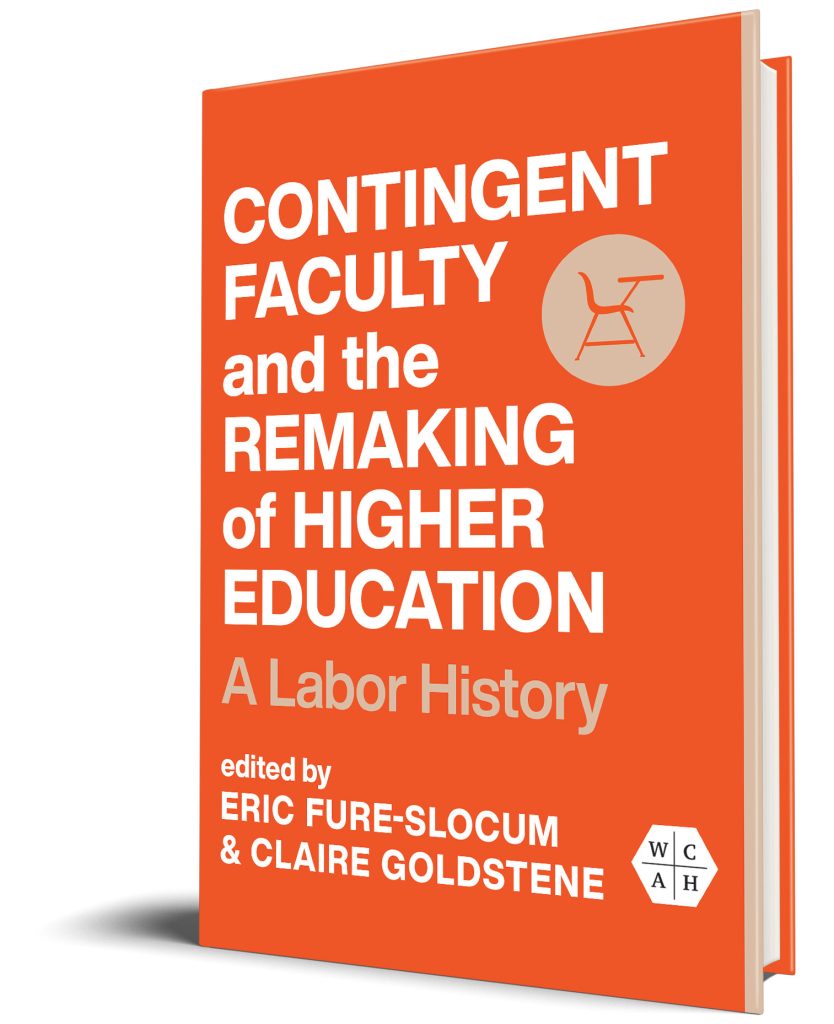The editors of Contingent Faculty and the Remaking of Higher Education: A Labor History, answer questions on their new book.
Q: Why did you decide to write this book?
As historians with training in labor history, we saw the need for a book that grappled with the increasing precarity of academic workers and brought together a range of voices and perspectives. Why had academic employment in higher ed changed so dramatically from the 1970s to the present, with a preponderance of tenure stream positions being replaced by a super-majority now of adjuncts and contingent faculty? How was academic work changing? How were students and higher ed workers, especially those on the contingent faculty track, affected? How were contingent faculty responding and organizing? How were these changes reshaping higher education?
Both of us had considerable experience working as contingent faculty and had been involved in adjunct organizing at the campus and national levels, with informal task forces, labor and advocacy groups, and professional organizations. We first met each other while serving as co-chairs of the Labor and Working-Class History Association’s contingent faculty committee. So, this collection emerged from our scholarly backgrounds and our activism.
Q: What is the most interesting discovery you made while researching and writing your book?
In putting together this volume, we were able to bring together an extraordinary group of dedicated contributors. This volume, while structured as a labor history, is a truly interdisciplinary collection of scholars, teachers, and activists. While we knew some contributors previously, working with this diverse group proved to be intellectually gratifying. We learned so much from each of the essays throughout the process. And since these chapters engage the issues around contingency at multiple levels—from the structural changes underlying this shift in higher education to the everyday experiences of adjuncts in many different disciplines to the challenges and accomplishments of organizing—we as editors kept learning. We now look forward to sharing this with readers.
We also should mention that, while work on this collection began before COVID, much of its life spanned those years when educators’ and scholars’ lives were upended. Despite contributors’ many challenges, they stuck with this project. So, while we already had a sense of this, we discovered and were gratified by the dedication of all the contributors to completing the book.
Q: What myths do you hope your book will dispel or what do you hope your book will help readers unlearn?
We hope that this book dispels a number of myths about contingent faculty. First, while some level of contingency has long been present in higher education, the rapid growth in the number and proportion of contingent faculty over that past half century was not inevitable. Instead, it is the result of decisions and actions by policy makers, administrators, and some faculty that can and ought to be challenged. Second, the myth of meritocracy in higher education is difficult to dislodge. Whether someone ends up on the tenure stream or contingent track is much more a matter of accident and timing than merit. Today’s graduate students and younger faculty understand this reality, but many other faculty, as well as administrators and professional associations, need to continue grappling with this. Finally, we hope this volume contributes to breaking down the wall separating scholarship and activism. The essays, as well as the examples provided by our contributors’ lives and work, demonstrate the value of scholar activism.
Q: Which part of the publishing process did you find the most interesting?
Collecting the draft essays and then seeing the changes over the course of the editing and revision process was indeed gratifying. We are lucky to have such thought-provoking contributors, each telling significant stories and making important arguments. We also are grateful for the editors and others at the press who made this possible. But two moments in the process especially stand out. One was the work of giving the volume shape and working out a structure, now reflected in the table of contents of this labor history. Between sets of bookend essays that situate the volume in a larger context, the volume narrates a history of contingency in higher education—how we got here (the political economy and structure of contingent academic labor), what here looks like (adjuncts’ everyday experiences in the academic workplace), and how contingent faculty are responding (advocacy work, organizing, and collective bargaining). Accounts about the personal toll of contingency are woven throughout the collection. The second moment arrived toward the end of our process, soon before publication, when we finally had the opportunity to bring all the contributors together, even if only virtually. This is a group of engaged scholars, eager to not only understand how contingency has changed higher education but also to reclaim education’s public purpose.
Q: What is your advice to scholars/authors who want to take on a similar project?
An edited volume takes a long time and a lot of work. While requiring a different set of skills than a monograph, it too can be demanding yet satisfying intellectual work. Having a good co-editor makes a world of difference. While we divided up some of the work, we also consulted with one another at every step along the way and provided two sets of eyes for each essay and every part of the book. We also tried to keep contributors in the loop throughout the process, putting an emphasis on regular and thorough (maybe too thorough sometimes!) communication.
Eric Fure-Slocum is a non-tenure-track associate professor of history at St. Olaf College. He is a coeditor of Civic Labors: Scholar Activism and Working-Class Studies.
Claire Goldstene taught as a contingent faculty member at numerous universities. She is the author of The Struggle for America’s Promise: Equal Opportunity at the Dawn of Corporate Capital.

